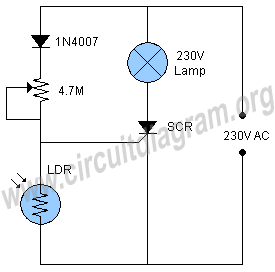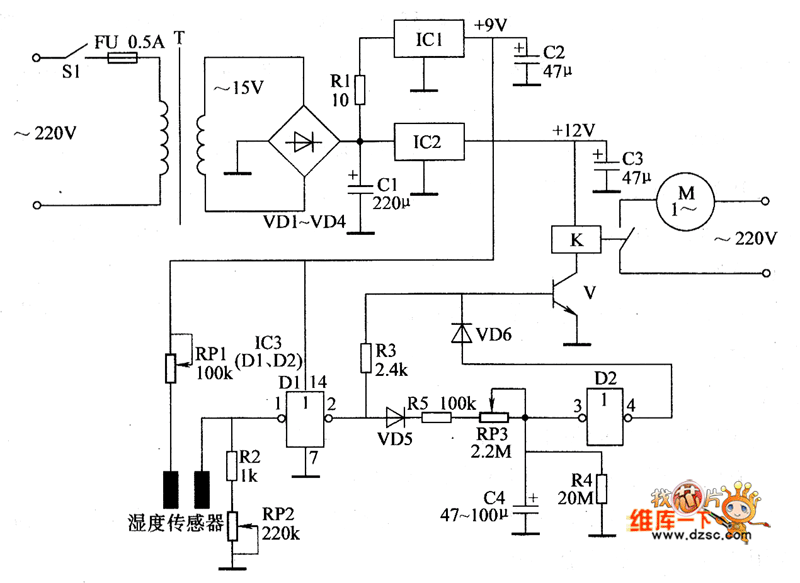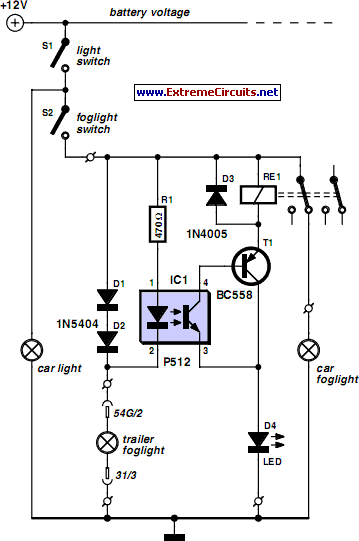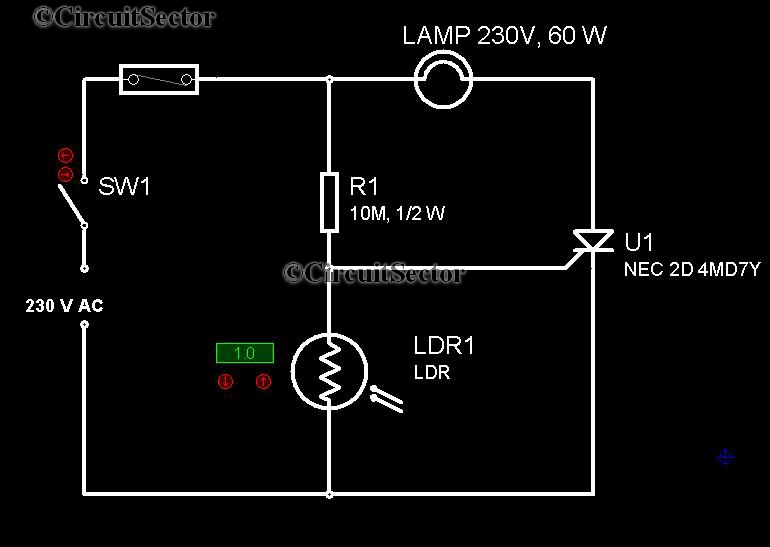
automatic night lamp 230v

This project involves a simple automatic night lamp circuit, also known as a dark-activated 230V lamp circuit. The circuit is designed to automatically activate an AC lamp or bulb at sunset or when it detects a lack of light. It is straightforward to construct, requiring no more than five components. The light-dependent resistor (LDR) functions as a light/dark sensor, while the silicon-controlled rectifier (SCR) acts as a switch. When light strikes the LDR, its resistance decreases, keeping the SCR in the off state. Conversely, in the absence of light, the LDR's resistance increases, turning on the SCR and allowing 230V AC voltage to flow through it, thereby powering the lamp. The circuit's sensitivity can be adjusted using a 4.7M variable resistor. Caution is advised, as many points in the circuit are at AC mains voltage, which poses a risk of lethal shock. Individuals unfamiliar with handling AC line voltages should refrain from attempting to build this circuit.
The automatic night lamp circuit operates on the principle of light detection and control using fundamental electronic components. The core of the circuit is the LDR, which changes its resistance based on ambient light levels. In bright conditions, the LDR maintains low resistance, preventing the SCR from turning on. As darkness falls, the resistance of the LDR increases, triggering the SCR to conduct. This action allows the AC voltage to flow to the lamp, illuminating it automatically.
The SCR is a crucial component in this design, functioning as a switch that can handle high voltage and current. It remains off until triggered by the LDR, ensuring that the lamp only activates under the desired conditions. The 4.7M variable resistor provides an adjustable sensitivity setting, allowing the user to fine-tune the light threshold at which the lamp activates. This feature is particularly useful in varying environmental conditions, such as different times of the year or locations with differing ambient light levels.
When designing this circuit, it is essential to ensure proper insulation and safety measures, especially since it operates at 230V AC. Use components rated for the required voltage and current, and ensure that all connections are secure to prevent short circuits or accidental contact with live parts. A suitable enclosure should be used to house the circuit, providing additional safety and protecting the components from environmental factors.
Overall, this automatic night lamp circuit exemplifies a simple yet effective application of basic electronic principles, providing convenience and energy savings by only activating when needed.Here is a project of a simple automatic night lamp circuit or dark activated 230V lamp circuit, which will automatically activate an AC lamp / bulb when sun set or if the circuit will receive no light. The circuit is very easy to build using no more than five components. The LDR is working as a light/dark sensor and SCR is working as a switch. Whe n light falls on the LDR its resistance will decrease and the SCR will remain in the off condition but when the LDR will receive no light its resistance increases which will switch on the SCR and 230V AC voltage will start passing through the SCR which will power on the 230V lamp. The sensitivity of the circuit can be adjusted with 4. 7M variable resistor. Note: Many of its points are at AC mains voltage. It could give you lethal shock if you are not careful. If you don`t know much about working with AC line voltages do not attempt to construct this circuit. 🔗 External reference
The automatic night lamp circuit operates on the principle of light detection and control using fundamental electronic components. The core of the circuit is the LDR, which changes its resistance based on ambient light levels. In bright conditions, the LDR maintains low resistance, preventing the SCR from turning on. As darkness falls, the resistance of the LDR increases, triggering the SCR to conduct. This action allows the AC voltage to flow to the lamp, illuminating it automatically.
The SCR is a crucial component in this design, functioning as a switch that can handle high voltage and current. It remains off until triggered by the LDR, ensuring that the lamp only activates under the desired conditions. The 4.7M variable resistor provides an adjustable sensitivity setting, allowing the user to fine-tune the light threshold at which the lamp activates. This feature is particularly useful in varying environmental conditions, such as different times of the year or locations with differing ambient light levels.
When designing this circuit, it is essential to ensure proper insulation and safety measures, especially since it operates at 230V AC. Use components rated for the required voltage and current, and ensure that all connections are secure to prevent short circuits or accidental contact with live parts. A suitable enclosure should be used to house the circuit, providing additional safety and protecting the components from environmental factors.
Overall, this automatic night lamp circuit exemplifies a simple yet effective application of basic electronic principles, providing convenience and energy savings by only activating when needed.Here is a project of a simple automatic night lamp circuit or dark activated 230V lamp circuit, which will automatically activate an AC lamp / bulb when sun set or if the circuit will receive no light. The circuit is very easy to build using no more than five components. The LDR is working as a light/dark sensor and SCR is working as a switch. Whe n light falls on the LDR its resistance will decrease and the SCR will remain in the off condition but when the LDR will receive no light its resistance increases which will switch on the SCR and 230V AC voltage will start passing through the SCR which will power on the 230V lamp. The sensitivity of the circuit can be adjusted with 4. 7M variable resistor. Note: Many of its points are at AC mains voltage. It could give you lethal shock if you are not careful. If you don`t know much about working with AC line voltages do not attempt to construct this circuit. 🔗 External reference





